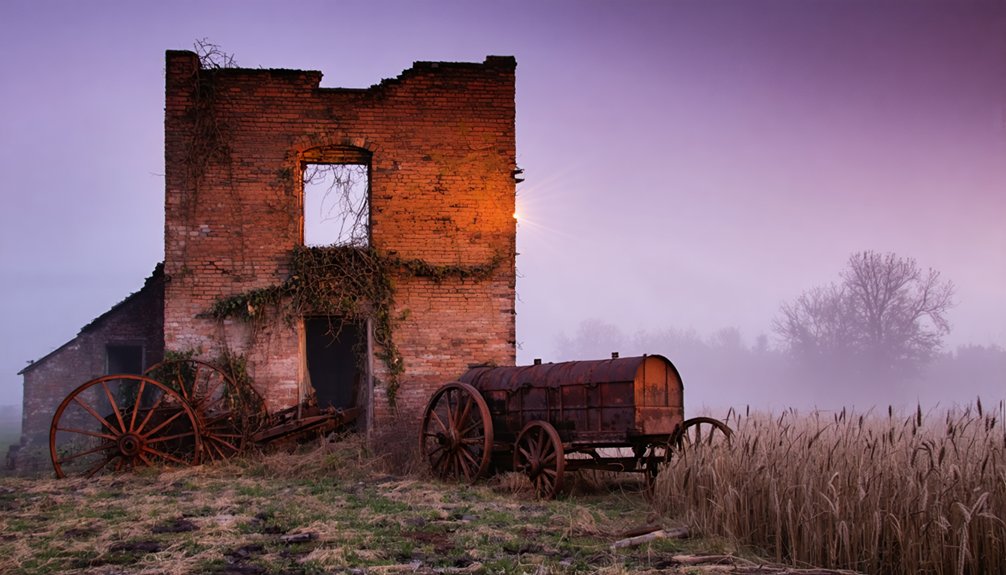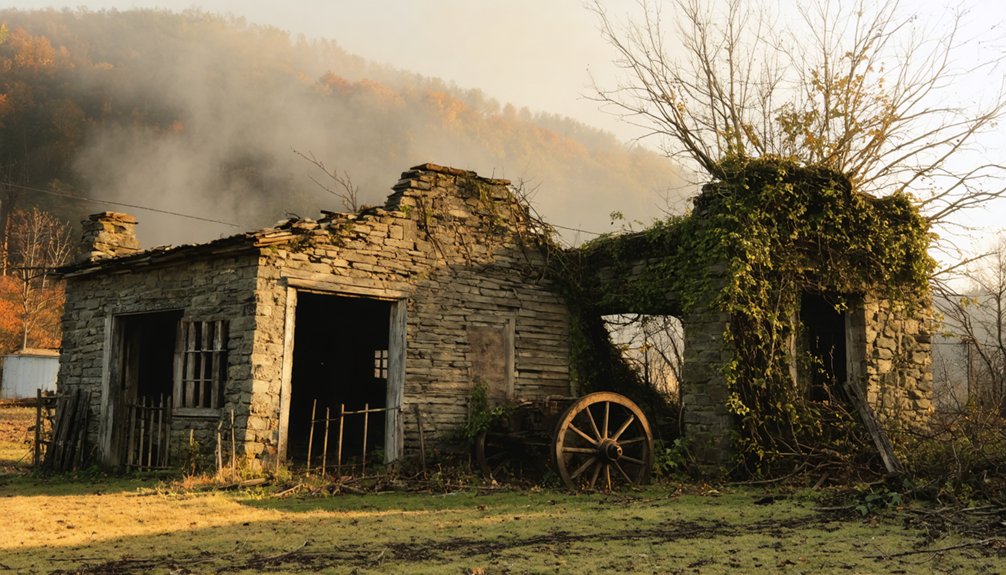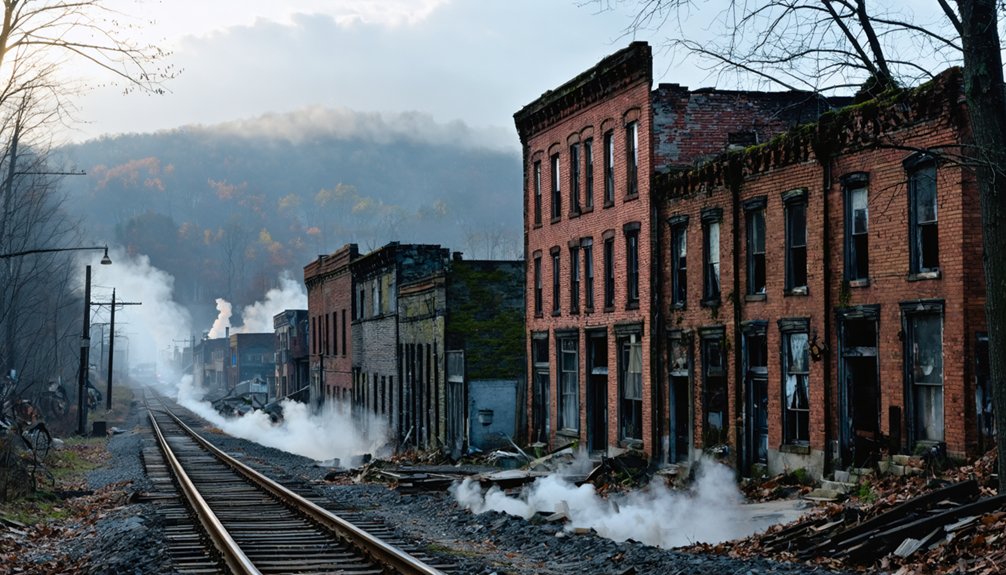When exploring Civil War ghost towns, always research the site’s history through archives and maps before visiting. Verify land ownership to prevent trespassing and secure necessary permissions. Pack safety essentials including sturdy boots, first aid kits, and lighting tools. Assess structural stability carefully before entering any buildings. Document findings ethically without disturbing artifacts. Distinguish between local folklore and historical facts. Connect with historical societies for deeper context. These precautions transform casual exploration into meaningful historical investigation.
Key Takeaways
- Verify property ownership and obtain proper permissions before visiting to avoid trespassing on private land.
- Assess structural integrity by checking for compromised foundations, unstable walls, or weak floors before entering buildings.
- Bring essential safety gear including sturdy boots, gloves, headlamps, and first aid supplies.
- Document discoveries ethically with GPS coordinates while distinguishing between folklore and verified historical facts.
- Research historical context through archives, maps, and local historical societies to understand the town’s significance.
Research the Historical Context Before Your Visit
Before starting your journey to Civil War ghost towns, understanding the historical context is essential for appreciating what you’ll encounter.
Begin by examining state archives that contain records detailing when towns flourished and why they were abandoned. These documents reveal compelling stories of destruction patterns from military campaigns like Sherman’s march through Georgia, which systematically decimated settlements like Cassville.
Cross-reference multiple historical maps to track how town locations changed or disappeared entirely. Land records and property ownership documents will help you pinpoint exact locations and understand who lived there.
Pay attention to environmental factors too—many ghost towns were later submerged by water infrastructure projects like Kentucky Lake, which covered the ruins of Johnsonville where Confederate forces had destroyed millions in Union supplies. Many of these abandoned towns witnessed landmark battles that significantly altered the trajectory of the war and their own futures. The war’s aftermath created a haunting stillness in these abandoned communities that persists to this day.
This research transforms your visit from mere sightseeing into an immersive historical experience.
Maneuvering the complex web of property rights presents one of the most challenging aspects of exploring Civil War ghost towns. Before venturing out, verify whether your destination sits on public or private land, as trespassing carries serious legal implications.
Many sites exist in ownership limbo due to eminent domain actions or heirs’ property complications, particularly affecting Black families’ historical land claims. Be aware that just compensation for property taken by the government through eminent domain often falls below market value, leading to contested ownership.
Always contact local historical societies or government offices to confirm property ownership status and obtain necessary permissions. Look for posted signage indicating boundaries and respect these limitations without exception. Warning signs should be taken seriously as they often indicate dangerous structural conditions or protected historical areas.
Verify ownership through official channels before exploring—boundary signs aren’t suggestions but legal imperatives demanding your respect.
When required, secure written consent from landowners before entering their property. Remember that many artifacts are protected by preservation laws, making their removal illegal regardless of land status. Your freedom to explore depends entirely on your willingness to navigate these legal frameworks responsibly.
Pack Essential Safety Gear for Remote Locations
Exploring Civil War ghost towns demands five categories of vital safety equipment to protect you from the unique hazards these remote locations present.
First, invest in protective clothing—sturdy hiking boots with ankle support, cut-resistant gloves, and a safety helmet to shield against structural debris.
Second, don’t compromise on lighting tools; carry headlamps and backup batteries to navigate dark structures safely. Hands-free exploration is critical when climbing through unstable ruins or examining artifacts.
Your essential gear should include thorough first aid supplies with bandages, antiseptics, and respiratory protection against potentially harmful particulates.
Personal protection devices like pepper spray offer security against wildlife encounters.
Finally, preparation for hazardous terrain requires researching the specific location, carrying offline navigation aids, and communicating your plans with someone trustworthy.
These safety precautions aren’t optional luxuries—they’re vital safeguards in environments where help may be hours away.
Travel with a companion whenever possible as exploring with buddies provides additional safety and enhances the experience through shared observations and discussions.
Document Your Discoveries Responsibly
When documenting Civil War ghost towns, prioritize ethical photography by capturing structures without disturbing artifacts or trespassing on restricted areas.
Consider maintaining both digital records (with GPS coordinates and timestamps) and physical field notes to guarantee your discoveries remain preserved even if technology fails.
Your careful documentation can contribute valuable historical data when shared through official channels such as state historic registries, local preservation societies, and national database projects that track vanishing Civil War sites.
Photography Ethics First
Before you capture your first image of a Civil War ghost town, establishing a foundation of ethical photography practices becomes essential for preserving these fragile historical sites.
Always obtain explicit permission before photographing private property or culturally sensitive areas, and avoid restricted zones without proper authorization.
Your photography should practice ethical storytelling by truthfully documenting these locations without staging or manipulating scenes. Building trust through community engagement before photography increases the likelihood of accessing sites with historical significance. Consider using non-intrusive techniques that respect the integrity and atmosphere of these historic locations.
Maintain cultural sensitivity by considering how your images might impact communities connected to these historical places.
Never remove artifacts or disturb ruins for a better composition, and use equipment that minimizes your environmental footprint.
Remember that your photographs serve as historical documentation—share them responsibly with accurate context that educates rather than sensationalizes these powerful remnants of our complex past.
Digital vs. Physical Records
The distinction between digital and physical record-keeping becomes critical when documenting Civil War ghost towns, as each approach offers unique advantages for historical preservation.
While digital archives provide efficient keyword searches across collections like the Freedmen’s Bureau Records, they can’t replace the tactile connection of examining original handwritten records that reveal personal stories of settlement decline.
When documenting your discoveries, cross-reference physical field observations with both types of sources. Photograph foundations and structures, then validate their origins through Library of Congress catalogs and National Archives documents.
Digital tools enable preliminary research from home, but physical archives contain nuanced details in labor contracts and narrative reports that digital scans might miss.
The most compelling documentation combines field evidence with thoroughly researched archival context from both mediums. Many abandoned communities from the 1880-1940 period have heritage tourism potential that can be enhanced through proper documentation methods.
Documenting your Civil War ghost town discoveries through official historic registries serves as an essential step in preserving America’s fragmented past for future generations.
When submitting findings to the National Register of Historic Places, include precise geographic coordinates, township information, and archaeological evidence that authenticates your site’s historical significance.
Submit your documentation with standardized forms available through federal archives, ensuring your materials follow established preservation methods.
Catalog all photographs, artifacts, and physical evidence with dates, coordinates, and contextual details before submission. Supporting documentation should incorporate land records, property deeds, and historical maps that verify the ghost town’s identity.
Remember that historic registries require verification through multiple sources—triangulate your findings using property records, tax documents, and plat maps to establish the site’s authenticity before seeking official recognition.
For additional research assistance, visit the State Archives of Florida where specialized resources are available for ghost town investigations without appointment during regular business hours.
Prepare for Structural Hazards and Environmental Challenges
When exploring Civil War ghost towns, you’ll need to carefully assess building stability by checking for cracked foundations, rotting support beams, and compromised walls before entering any structure.
Weather conditions greatly impact both safety and accessibility, with spring flooding, summer vegetation overgrowth, and winter ice creating unique hazards during different seasons.
You must also prepare for encounters with wildlife that has reclaimed these abandoned spaces, including venomous snakes, nesting birds, and territorial mammals that may perceive your presence as a threat.
Unstable Buildings Assessment
Exploring abandoned Civil War ghost towns presents significant structural hazards that require careful assessment before entry.
Before stepping inside any structure, conduct a thorough visual inspection for telltale signs of compromised structural integrity: look for leaning walls, sagging roofs, missing support beams, and cracked foundations.
Test wooden floors with a probing stick before putting your full weight on them, as water damage and rot can create dangerous weak spots.
Pay attention to displaced brickwork or masonry—these indicate potential wall instability.
Don’t ignore environmental factors; overgrown vegetation may conceal weaknesses or actively damage foundations, while moisture cycles accelerate decay.
When in doubt about a building’s stability, use a drone for remote assessment rather than risking personal safety.
Remember to wear appropriate protective gear including sturdy boots, gloves, and possibly a helmet.
Seasonal Weather Impacts
Weather patterns throughout the year greatly impact the structural integrity and safety conditions of Civil War ghost towns, requiring explorers to adapt their preparation strategies seasonally.
During winter, extreme cold causes frost heave in foundations, while summer’s heat accelerates wood deterioration and creates dust hazards. The freeze-thaw cycles of late fall and early spring particularly threaten masonry and metal components.
Precipitation effects pose serious risks as heavy rains saturate soil, destabilizing structures and creating hazardous mud conditions.
Spring’s vegetation growth can obscure dangerous terrain features while trapping moisture against ruins.
You’ll need season-specific gear: insulated clothing with traction aids for winter, waterproof boots for wet conditions, and sun protection during summer.
Always check weather forecasts before visiting—just as seasonal temperatures once disrupted Civil War campaigns, they’ll determine your exploration safety today.
Wildlife and Vegetation
The lush vegetation and diverse wildlife inhabiting Civil War ghost towns create a deceptive environment where structural dangers often remain hidden beneath nature’s reclamation.
When exploring, always scan for poisonous plants that thrive in abandoned territories—they require identification before contact. Dense overgrowth conceals treacherous holes, unstable foundations, and weakened structures with artillery-damaged support beams.
Wildlife encounters increase greatly during evening hours, so plan your exploration during daylight. Bears potentially inhabit remote mountainous locations, while ticks present serious health risks throughout Appalachian regions. Snakes and insects hide within the vegetation, creating unexpected hazards.
Remember that moss-covered surfaces disguise dangerous drop-offs and compromised terrain. The forest’s beautiful reclamation process simultaneously creates the explorer’s greatest challenge—what appears picturesque often masks the most dangerous structural deterioration.
Separate Folklore From Historical Fact
When visiting Civil War ghost towns, you’ll quickly discover that separating folklore from historical fact becomes essential for understanding these haunted landscapes.
While intriguing tales of headless soldiers at Droop Mountain or General Washington’s ghost at Gettysburg enhance the experience, rely on primary sources like military reports and cemetery records for historical verification.
Apply folklore analysis to recognize that many ghost stories emerged as communities processed war trauma. Tales often began at veterans’ reunions or through local storytelling, gradually blending documented events with embellishments.
Sites like the Jennie Wade House contain verified history, but reported phenomena remain anecdotal.
Don’t dismiss these stories entirely—they served important social functions in maintaining community memory and shared grief.
Instead, appreciate them as cultural artifacts while grounding your exploration in verifiable historical context.
Connect With Local Historical Societies

Local historical societies serve as invaluable gateways to discovering Civil War ghost towns beyond what’s visible in abandoned landscapes.
These organizations maintain extensive records, including land deeds, military documents, and family correspondence that aren’t accessible through standard archives.
When initiating contact, specifically inquire about ghost town preservation efforts and volunteer opportunities. Society members often have established relationships with private landowners, facilitating access to otherwise restricted sites.
Their mapping collections, which include survey records and plat books, can pinpoint vanished settlements with precision.
Don’t overlook the oral histories these societies collect. Through historical society collaboration, you’ll gain access to recorded interviews with community members who possess generational knowledge about abandoned towns.
These firsthand accounts provide cultural context and daily life details that written documentation alone can’t convey.
Frequently Asked Questions
Can Children Safely Explore Civil War Ghost Towns?
Children can explore Civil War ghost towns with proper supervision. You’ll need to prioritize child safety through guided tours, maintain constant vigilance, and avoid deteriorating structures that pose serious hazards.
How Do Seasonal Changes Affect Ghost Town Accessibility?
Seasonal weather dramatically transforms ghost town accessibility. You’ll face snow blockages in winter, muddy trails in spring, crowded but accessible conditions in summer, and early closures with unpredictable conditions in fall.
What Photography Equipment Works Best in Abandoned Structures?
You’ll need a mirrorless camera with high ISO capability, wide-angle lenses for spacious interiors, and stable tripods for low-light conditions. Prioritize lens selection with wide apertures and guarantee tripod stability on uneven surfaces.
Are Metal Detectors Allowed at Civil War Ghost Towns?
No, you can’t freely use metal detectors. Metal detecting regulations prohibit use at federally protected sites, while historical preservation concerns require permits or written permission from private landowners elsewhere.
How Can I Distinguish Between Natural Decay and Battle Damage?
Look for concentrated damage patterns and sharp fractures versus gradual natural wear. Battle damage compromises structural integrity suddenly, while weathering affects buildings randomly and incrementally over extended periods.
References
- https://devblog.batchgeo.com/ghost-towns/
- https://www.battlefields.org/sites/default/files/atoms/files/Research and Writing Guide.pdf
- https://www.christywanders.com/2024/08/top-ghost-towns-for-history-buffs.html
- https://m.dresshead.com/files/scholarship/Documents/Ghost_Towns_Lost_Cities_Of_The_Old_West_Shire_Usa.pdf
- https://www.mentalfloss.com/geography/american-ghost-towns-can-still-walk-through
- https://noospheregeologic.com/blog/tag/ghost-towns/
- https://www.mythfolks.com/haunted-us-ghost-towns
- https://www.youtube.com/watch?v=zRfBNdUOgOQ
- https://www.visittheusa.com/experience/5-us-ghost-towns-you-must-see
- https://en.wikipedia.org/wiki/American_Civil_War



